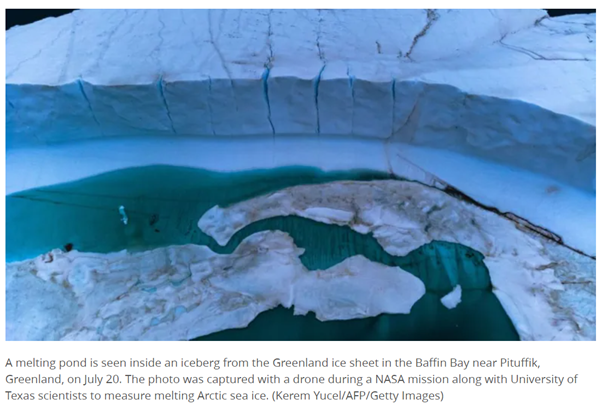

31st August 2022 (6 Topics)
Context
A new study finds that Greenland has more than 120 trillion tons of ice that can be thought of as zombie ice that's going to raise sea level globally by at least 10 inches.
About
- The melting of the Greenland ice sheet will unavoidably raise the global sea levels by at least 10.6 inches or 27 centimetres, no matter what climate action the world decides to take right now.
- This is because of ‘zombie ice’, which is certain to melt away from the ice cap and blend into the ocean.
Zombie Ice:
- Zombie Ice referred to as dead or doomed ice.
- It is one that is not accumulating fresh snow even while continuing to be part of the parent ice sheet.
- Such ice is “committed” to melting away and increasing sea levels.
- It's dead ice. It's just going to melt and disappear from the ice sheet.
- This ice has been consigned to the ocean, regardless of what climate (emissions) scenario we take now.

Key findings of the study:
- The unavoidable ten inches in the study is more than twice as much sea level rise as scientists had previously expected from the melting of Greenland's ice sheet.
- Intergovernmental Panel on Climate Change (IPCC) report in 2021 projected a range of 2 to 5 inches (6 to 13 centimeters) for likely sea level rise from Greenland ice melt by the year 2100.
- 3% of Greenland's total ice volume will melt no matter what happens with the world cutting carbon pollution.
- The study says it could reach as much as 30 inches (78 centimetres) if Greenland’s record melt year (2012) becomes a routine phenomenon.
Consequences:
- According to the UN Atlas of the Oceans, 8 of the world’s 10 largest cities are near a coast. Rising sea levels will make flooding, high tides and storms more frequent and worse as their impact will reach more inland.
- This, in turn, means a threat to local economies and infrastructure.
- Also, low lying coastal areas will take a harder hit.
- The World Economic Forum’s 2019 Global Risks Report noted that “already an estimated 800 million people in more than 570 coastal cities are vulnerable to a sea-level rise of 0.5 metres by 2050”.
Possible emerging processes that the models don’t account for increasing ice sheet’s vulnerability:
- Increased rain is accelerating surface melt and ice flow.
- In August 2021, rain fell at the Greenland ice sheet summit for the first time on record. Weather stations across Greenland captured rapid ice melt.
- Large tracts of the ice surface are undergoing bio-albedo darkening, which accelerates surface melt, as well as the impact of snow melting and refreezing at the surface.
- These darker surfaces absorb more solar radiation, driving yet more melt.
- Warm, subtropical-originating ocean currents are intruding into Greenland’s fjords and rapidly eroding outlet glaciers, undercutting and destabilizing their calving fronts.
- Supraglacial lakes and river networks are draining into fractures and moulins, bringing with them vast quantities of latent heat.
- This “cryo-hydraulic warming” within and at the base of the ice sheet softens and thaws the bed, thereby accelerating interior ice flow down to the margins.
More Articles

